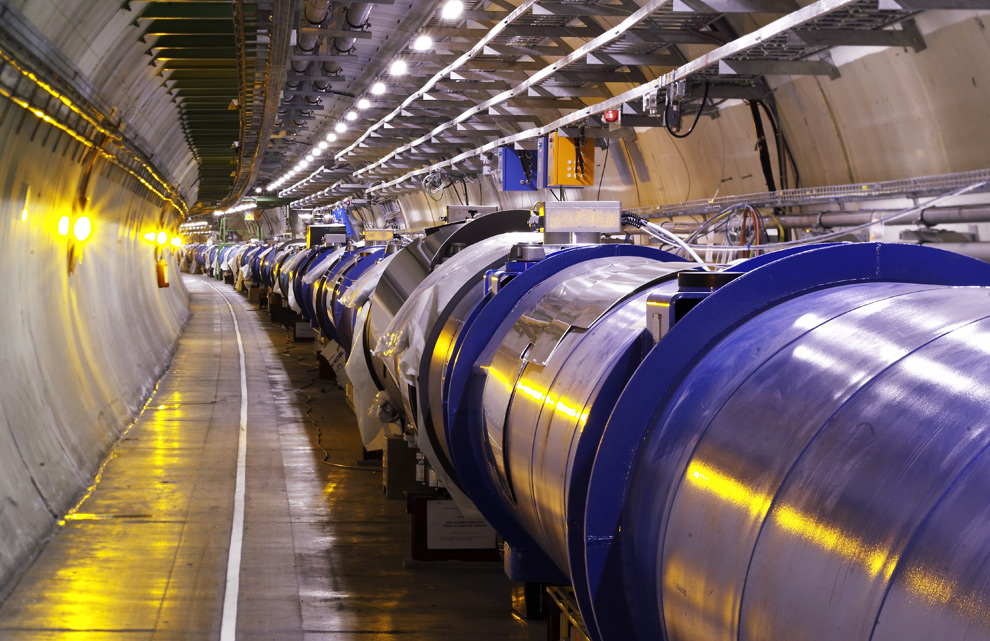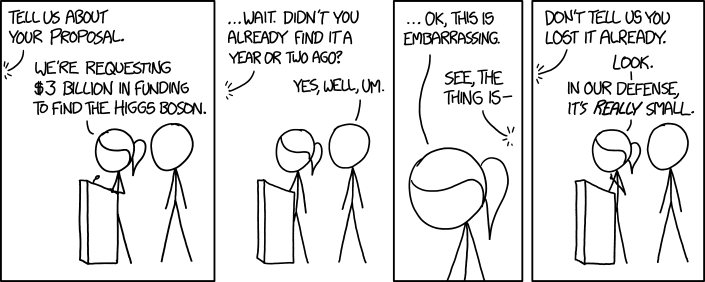by Talya Klinger, Homeschooler
 How does your research on subatomic particles relate to matter
on a larger scale? In other words, how do you answer people's questions about
why your research on matter matters?
How does your research on subatomic particles relate to matter
on a larger scale? In other words, how do you answer people's questions about
why your research on matter matters?
After the discovery of the Higgs Boson in 2012, the Large Hadron Collider (LHC), near Geneva,
Switzerland, shut down for upgrades so that it would be able to accommodate
even higher-energy collisions.
Dr. Lauren Tompkins, a physicist and assistant
professor at Stanford University who worked on the ATLAS experiment at the LHC, conducts research on
subatomic particles and what they can tell us about matter in general. She spoke to Marin Science Seminar on March 25, 2015 about her work. What's
next for the LHC when it comes back online in spring, 2015?
In Dr. Tompkins's words:
First things first: what made you decide to become a physicist?
I became a physicist for
several reasons, but the earliest motivation for me was the fact that in all of
my science classes, I kept asking the annoying question: “But, why?” If you keep asking why in biology (“why
do the cells organize that way?”), then you end up with chemistry, and if you
do the same with chemistry (“why do the molecules have that structure?”), you
end up with physics. Particle physics, in my opinion, is the ultimate way to
ask that question through experimentation.
I started working on the
ATLAS experiment as a post-bac student in 2004, and have been loving it ever
since. It’s such a massive project that I’ve been able to work on everything
from software to hardware, from analysis of the simplest possible proton
interactions, to simulations of what crazy new physics models would look like
to us. I was lucky enough as a graduate student to be at CERN, in the
experiment control room, taking detector operation shifts during the first few
months of high energy collisions. That was pretty special.
Another aspect of working
on ATLAS that I love is the fact that I have over 3000 collaborators from all
over the world. I get to work collaboratively with a large fraction of the
scientists in my field of research. If I were doing a different type of
science, I would probably be competing against them. And, although I’m a pretty
competitive person, I would much rather work together on a team and build
something great than try to do everything myself.
Once the Large Hadron Collider is back in operation, what's
next?
We’ll have two main
objectives. First, we need to study the newly discovered Higgs boson in much
greater detail. It’s the first new fundamental particle we’ve discovered since
1994, and its properties--specifically how it interacts with other
particles--will be key to understanding the larger structure of matter.
Secondly, we are going to be searching for evidence of physics beyond the
Standard Model of particle physics (our theory of how particles interact). For
example, from astronomy and cosmology, we know that dark matter exists, but we
can’t find a place for it in the Standard Model. So we are going to be looking
for it at the LHC and trying to figure out how it connects to normal
matter--the stuff that you and I are made of. We are also going to be looking
for evidence of extra dimensions, trying to find hypothesized super-partners of
the standard model particles and searching for signs that perhaps there is
something smaller than quarks.
 How does your research on subatomic particles relate to matter
on a larger scale? In other words, how do you answer people's questions about
why your research on matter matters?
How does your research on subatomic particles relate to matter
on a larger scale? In other words, how do you answer people's questions about
why your research on matter matters?
That is always a tough
question to answer because there are so many challenges in the world right now
and sometimes it’s hard to draw the line from the LHC to solving those
problems. But, I do firmly believe that striving to understand the natural
world is such a fundamental part of humankind that we need, and are driven, to
do research like the LHC. In fact, given its scale and the sheer number of
people involved, the LHC is such a beautiful example of that drive. And, of
course, in trying to push the boundaries of human knowledge, we produce
technologies that make their way into the public sphere as well. Personally, I
anchor my work on the LHC to expanding access to science and technology careers
to people who have traditionally been excluded from it. There is no reason that
these explorations should be reserved for the overwhelming white and male
population who have traditionally been dominant.
Do you have any advice to share with high school students who
are interested in studying particle physics?
Particle physics is
wonderful because there is so much of it that you can understand by reading.
So, read popular science books, like those by Lisa Randall and Sean
Carrol. And watch the film
Particle Fever. It does an amazing job of capturing what it’s like. Also, take as much math as possible and
don’t be afraid of it! Math is a
lot of work, but it is the language of science--you need to be fluent in
it! And, just like you aren’t born
“being good” at speaking or reading, you aren’t born “being good” at math. Math
takes just as much hard work as learning to speak or read; we just learn it
slower because we don’t use it as much.
Finally, do you have a favorite subatomic particle? (I'm
partial to the neutrino, myself.)
I love all my particles
equally! But, if I had to choose, I guess it would be the Z boson. We’ve learned so much about the
Standard Model by studying it, and it is pretty democratic in its decays.
http://cms.web.cern.ch/news/first-z-bosons-detected-cms-heavy-ion-collisions
http://cms.web.cern.ch/news/first-z-bosons-detected-cms-heavy-ion-collisions
 |
| Figure 1: Candidate Z boson decaying to two electrons (two tallest red towers) in a lead-lead heavy ion collision at CMS. The other red and blue towers indicate energy deposits in CMS from other particles produced. |
Figure 2: Candidate Z boson decaying to two muons (two red
lines) in a lead-lead heavy ion collision at CMS. The green indicates energy
deposits in CMS from other particles produced.
Image Sources:








No comments:
Post a Comment